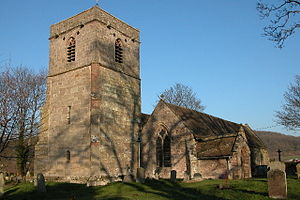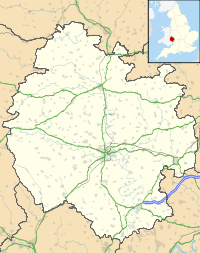- St Cuthbert's Church, Holme Lacy
-
St Cuthbert's Church, Holme Lacy 
St Cuthbert's Church, Holme Lacy, from the southwestLocation in Herefordshire Coordinates: 52°00′34″N 2°37′48″W / 52.0094°N 2.6301°W OS grid reference SO 568 347 Location Holme Lacy, Herefordshire Country England Denomination Anglican Website Churches Conservation Trust History Dedication Saint Cuthbert Architecture Functional status Redundant Heritage designation Grade I Designated 26 January 1967 Architectural type Church Style Gothic Groundbreaking 12th century Completed 16th century Specifications Materials Sandstone, tile roofs St Cuthbert's Church, Holme Lacy, is a redundant Anglican church about 1 mile (1.6 km) to the southeast of the village of Holme Lacy, Herefordshire, England. The church stands in an isolated position at the end of a lane in a bend of the River Wye. It has been designated by English Heritage as a Grade I listed building,[1] and is under the care of the Churches Conservation Trust.[2]
Contents
History
The land on which the church is built was given after the Norman conquest by William the Conqueror to Walter de Lacy. The estate later passed by marriage to the Scudamore family,[3] who became its patrons.[2] It remained in the possession of that family until 1909–10 when it was bought by Sir Robert Lucas-Tooth, 1st Baronet.[3] The Domesday Book records a priest at Holme Lacy, which implies that a church was present at that time. The church is now in an isolated position, but earthworks in its vicinity suggest that a village existed nearby, which subsequently became deserted.[4] The fabric of the present church originates from the 13th century. The tower was added in the 14th century, and a north chapel and south porch followed in the 16th century.[5] In 1833 a gallery was built and an organ given to the church. By 1924 the gallery had been removed and the old organ replaced by a new one. During this year extensive repairs to the roof, arcade and floors were carried out at a cost of about £1,000 (£42,000 as of 2011).[6][7]
Architecture
Exterior
St Cuthbert's is constructed in sandstone with tiled roofs. Its plan consists of a six-bay nave with two-bay chancel, and a north chapel. It has a south aisle extending to a south chapel at its east end, and a south porch. At the west end is a tower. The tower is in three stages, the upper two being separated by a string course. There are diagonal buttresses at the northwest and southwest corners. On the west wall in the bottom stage is an arched doorway over which is a small arched window. Above this in the middle stage is another window, this one being square-headed. The upper stage contains an arched, louvred bell opening on each side of the tower. Above each bell opening is a pair of trefoil windows. The parapet is plain. Along the north wall of the nave are three pairs of windows; above the west pair is a gabled dormer. There is a pair of similar windows on the north wall of the chancel. The east window of the chancel has three lights, and there is a buttress between this and the two-light east window of the south chapel. There is a gable cross on the apex of the north chapel and the chancel. Along the south wall is a variety of windows, including two lancet windows. The west window of the aisle has two lights. The south porch contains benches along each side.[1]
Interior
Fittings and furniture
The ceilings of the body of the church are plastered, while the wagon roof of the north chapel is open. Between the nave and the north chapel is a carved wooden screen. There is a piscina in the chancel, and another in the south chapel. The font dates from the 17th century, and consists of a round bowl on a cylindrical stem. It is carved with rosettes and cherubs. On the floor near the entry to the north chapel is a round stone bowl. The chancel contains a communion table dating from the 17th century, and on its east wall is panelling from the same period. In the church are two sets of choirs stalls dating possibly from the 15th century with misericords carved with such features as a grotesque head and a bird. There are other items from the 17th century, including carved benches, a chest and chairs. The lectern consists of a gilded eagle on an oak plinth dated 1914. On the walls are four hatchments, and near the south door is a benefactions board dated 1790.[1] At the west end of the church is a two-manual organ. This was built in 1912 at a cost of £300 (£22,000 as of 2011),[6] and was moved to the west end in 1924 at a cost of £36 (£1,500 as of 2011).[6][8] The ring consists of eight bells. These were all cast by Rudhall of Gloucester, six of them in 1709 and the other two in 1808 and 1829.[9]
Memorials
Most of the memorials in the church are to the Scudamore family. Between the chancel and the south chapel is a chest tomb dating from around 1550 bearing the alabaster effigies of John Scudamore and his wife Sibell. John Scudamore is dressed in armour, and his feet rest on a lion; she is dressed in a long gown. Along the sides of the tomb are shields containing coats of arms. On the north wall of the chancel is the white marble monument in Baroque style to James Scudamore who died in 1668. It contains a sculpture representing James Scudamore in a sitting position, wearing Roman dress. Above his head are two cherubs, and the whole is framed between two pilasters. To the left of this monument is one to his widow, Jane, also in Baroque style. In the south aisle is a wall monument to James Scudamore, 3rd Viscount Scudamore who died in 1716. This consists of a sarcophagus on which is an urn and two seated putti. Lower down, on each side of the sarcophagus, are two wreathed skulls. The whole is surrounded by Ionic columns and a broken segmental pediment. On the east wall of the south chapel is a monument to Mary Scudamore Stanhope who died in 1859. This was sculpted by Matthew Noble in white marble, and depicts a female figure standing in a niche. In the north chapel is another marble wall monument by Noble. This was to Chandos Scudamore Stanhope, a captain in the Royal Navy who died in 1871 and consists of an angel above an anchor.[1]
Stained glass
The glass in the east window of the south chapel depicts Cornelius and the angel, and is to the memory of Francis Brydges Scudamore Stanhope who died in 1855. In the east window of the chancel is a depiction of the Archangel Michael weighing souls and is to the memory of Sir Robert Lucas-Tooth who died in 1915. The north window of the chancel contains fragments of medieval glass. The east window of the south wall of the south aisle depicts the Good Samaritan and is a memorial to William Pitt Scudamore Stanhope who was vicar of the church from 1872 to 1892. In the north chapel is a window depicting Sir Galahad and Sir Bors to the memory of Sir Archibald Lucas-Tooth, 2nd Baronet who died in active service in the First World War in 1918. Also in the north chapel is a window commemorating Henry Scudamore-Stanhope, 9th Earl of Chesterfield who died in 1887.[1]
External features
To the south of the church is a churchyard cross constructed in sandstone. Its oldest parts, the base and the lower part of the shaft, date probably from the 14th century. The three stone steps, the upper part of the shaft and the cross date from a 20th-century restoration. The cross has been designated as a Grade II listed building.[10] Also to the south of the church are three further items designated as Grade II listed buildings. To the east of the porch is a wide grave headstone dated 1660.[11] Further to the west are two pairs of chest tombs. Those in the first pair are dated 1790 and 1847.[12] The other pair are surrounded by railings and date from about 1835.[13] To the east of the church are a gate with piers and attached walls. The gate and piers date probably from the later part of the 17th century, and the walls from later. The gates and the piers are in wrought iron, and the walls are sandstone. The overthrow contains an inscription and an achievement combining the Royal coat of arms and the arms of the Scudamore family. The gate, piers and walls constitute a Grade II* listed building. It is thought that they were moved from Holme Lacy House.[14]
See also
- List of churches preserved by the Churches Conservation Trust in the English Midlands
References
- ^ a b c d e "Church of St Cuthbert, Holme Lacy", The National Heritage List for England (English Heritage), 2011, http://list.english-heritage.org.uk/resultsingle.aspx?uid=1099563, retrieved 16 May 2011
- ^ a b St Cuthbert's Church, Holme Lacy, Herefordshire, Churches Conservation Trust, http://www.visitchurches.org.uk/Ourchurches/Completelistofchurches/St-Cuthberts-Church-Holme-Lacy-Herefordshire/, retrieved 29 March 2011
- ^ a b Anon., The History of Holme Lacy House Hotel, Holme Lacy House Hotel
- ^ Hurley, Heather, ed. (2008), Landscape Origins of the Wye Valley, The River Wye Preservation Trust and Logaston Press, ISBN 978-1904396-97-0, http://www.bosci.net/LOWV/Village%20pages%20-%20Holme%20Lacy.htm, retrieved 20 October 2010
- ^ Holme Lacy St Cuthberts church, Britain Express, http://www.britainexpress.com/counties/hereford/churches/Holme-Lacy.htm, retrieved 20 October 2010
- ^ a b c UK CPI inflation numbers based on data available from Lawrence H. Officer (2010) "What Were the UK Earnings and Prices Then?" MeasuringWorth.
- ^ Holme Lacy, Herefordshire, Kelly's Directory of Herefordshire, 1941, GENUKI, http://www.genuki.org.uk/big/eng/HEF/HolmeLacy/Kelly1941.html, retrieved 20 October 2010
- ^ Herefords, Holme-Lacy, St Cuthbert, British Institute of Organ Studies, http://www.npor.org.uk/cgi-bin/BOASearch.cgi?Fn=GSearch&boa_ref=6710&, retrieved 20 October 2010
- ^ Holme Lacy, S Cuthbert, Dove's Guide for Church Bell Ringers, http://dove.cccbr.org.uk/detail.php?searchString=holme+lacy&Submit=+Go+&DoveID=HOLME+LACY, retrieved 20 October 2010
- ^ "Churchyard cross about 10 yards southeast of the south porch of the Church of St Cuthbert, Holme Lacy", The National Heritage List for England (English Heritage), 2011, http://list.english-heritage.org.uk/resultsingle.aspx?uid=1348850, retrieved 16 May 2011
- ^ "Headstone about 4 yards east of the south porch of the Church of St Cuthbert, Holme Lacy", The National Heritage List for England (English Heritage), 2011, http://list.english-heritage.org.uk/resultsingle.aspx?uid=1099564, retrieved 16 May 2011
- ^ "Pair of chest tombs about 3 yards south of the south aisle of the Church of St Cuthbert, Holme Lacy", The National Heritage List for England (English Heritage), 2011, http://list.english-heritage.org.uk/resultsingle.aspx?uid=1099565, retrieved 16 May 2011
- ^ "Pair of chest tombs and surrounding railings about 10 yards south of the easternmost window of the south aisle of the Church of St Cuthbert, Holme Lacy", The National Heritage List for England (English Heritage), 2011, http://list.english-heritage.org.uk/resultsingle.aspx?uid=1348851, retrieved 16 May 2011
- ^ "Gate, gate piers and adjacent walls about 20 yards east of the south aisle of the Church of St Cuthbert, Holme Lacy", The National Heritage List for England (English Heritage), 2011, http://list.english-heritage.org.uk/resultsingle.aspx?uid=1157358, retrieved 16 May 2011
External links
 Media related to St Cuthbert's Church, Holme Lacy at Wikimedia CommonsCategories:
Media related to St Cuthbert's Church, Holme Lacy at Wikimedia CommonsCategories:- Grade I listed buildings in Herefordshire
- Grade I listed churches
- Church of England churches in Herefordshire
- 12th-century church buildings
- English Gothic architecture
- Churches preserved by the Churches Conservation Trust
Wikimedia Foundation. 2010.





